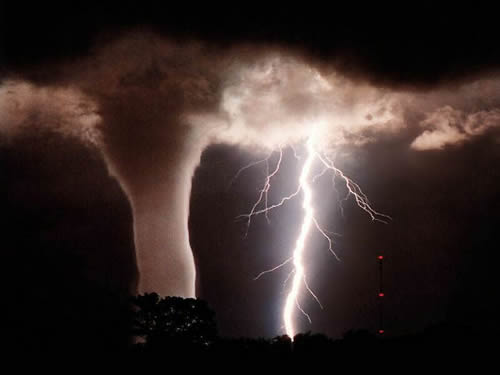|
Taney County Approved for Individual Assistance from FEMA for flooding!
Anyone with damage can register at 1-800-621-3362 (FEMA).
Deadline to Register July 8, 2011
has been extended to July 29, 2011
has been extended a second time to August 26, 2011
Lightning Related Safety

|
|
Statistics
|
- Missouri ranks 17th nationally in lightning deaths; 31st in lightning injuries
- 85% of lightning victims are children and young men between the ages of 10-35 engaged in recreational activities.
- 25% of strike victims die
- 40% of strike locations are unreported
- 27% are in open fields and recreational areas, other than golf courses.
- 14% of those are people standing under trees
- 5% of ALL lightning strikes occur on golf courses.
- Research shows sequential lightning strikes can be 6-8 miles apart.
|
|
The 30-30 Rule
|
- 30 seconds: Count the seconds between seeing lightning and hearing thunder. If the time is less than 30 seconds, lightning is still a potential threat. Seek shelter immediately.
- 30 minutes: After the last lightning flash, wait 30 minutes before leaving shelter. Half of all lightning deaths occur after the storm passes. Stay in a safe area until you are sure the treat has passed.
|
|
Lightning Safety - Indoors
|
- Inside stay away from doors and windows, metal pipes and floor vents.
- Electronic equipment: take off headsets, turn off televisions, computers, and do not use electronic appliances.
- Telephones and Cell phones are the leading cause of lightning injuries. Do not make a call unless it is an emergency.
|
|
Lightning Safety - Outdoors
|
- If you hear thunder, you are too close. All thunderstorms can produce lightning. Lightning often strikes as far as 10 miles away from rainfall. In the summer, watch the skies. If you see clouds forming with dark bases and increasing winds, go seek shelter indoors. Most people struck by lightning are not in the rain.
- Seek shelter inside a building! If you hear thunder go inside immediately. If there are no enclosed buildings get inside a hardtop all metal vehicle. Rain can get inside carports or covered patios; standing water can conduct electricity.
- If you hear thunder and your hair stands on end, suspend athletic activities! Get inside an enclosed sturdy building immediately. Stay ways from metal sheds, picnic, shelters, dugouts and bleachers. A hardtop metal vehicle will offer some protection, if you are not touching metal. Stay away from motorcycles and bicycles.
- Stay out of open areas! Over 50 percent of all lightning strikes occur in open spaces such as fields, ballparks, soccer fields and golf courses.
- Get out of water! Water conducts electricity! Before a thunderstorm arrives, seek shelter on shore. Swimming, wading or snorkeling are not safe. If lightning strikes water, the charge can travel some distance from the point of contact. If you are caught in a boat, move to the middle of the boat and crouch - do not touch any metal.
- Be the lowest point! Lightning strikes the tallest object i.e. trees, tall buildings, or mountains above tree lines.
- Stay away from trees! If there is no shelter, move out to the open and crouch. Make sure you are at least twice the distance from the tree in case the tree falls.
- Avoid metal! Large objects (exposed sheds, clothes lines) can conduct lightning and small objects (golf clubs, metal baseball bats, fishing rods, or tools) can cause burns.
- Move Away from People! Stay several yards away from other people. Do not share a bleacher bench or huddle in a group.
|
|
Help for Lightning Victims
|
- Call 911!
- Give First Aid, CPR, or Rescue Breathing immediately.
- Check for burns in two places. The injured person received and electrical shock and may be burned and/or badly injured.
|
|
Six Common Lightning Myths
|
- Lightning never strikes twice. It strikes the Empire State Building in New York City between 22-25 times each year.
- Rubber tires or foam pad will insulate me from lightning. It takes about 10,000 volts to create a one-inch spark. Lightning has millions of volts and easily can jump 10-12 feet.
- Lightning rods will protect my house or outdoor festivities. Lightning rods are "preferential attachment points" for lightning. You do not want to "draw" lightning to any area with people nearby.
- If lightning occurs, get off the water when boating, canoeing, or sailing. Tall trees and rocky outcrops along the shore and on nearby land may be a more dangerous place.
- A cave is a safe place in a thunderstorm. If it is a shallow cave or old mine with metallic filings nearby, it can be a deadly location during lightning.
- Injured persons carry an electrical charge. Injured persons do not carry an electrical charge and can be handled safely. Apply first Aid including CPR (if you are qualified) procedures to a lightning victim. Call 911 and send for help immediately.
|
|
(all information taken from the Missouri State Emergency Management Agency)
|
Additional Links
NWS Lightning Safety Overview
NWS Lightning Safety Handouts
|
|

